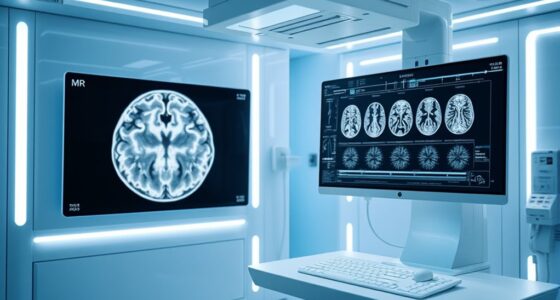Using AI for epidemic surveillance and response allows you to quickly detect outbreaks, analyze large datasets for hidden patterns, and accurately forecast disease trends. It supports proactive interventions, potentially saving lives. AI also improves logistics through robotics and automation, enhancing response efficiency. However, you must consider data privacy, security, and fairness to guarantee ethical use. Stay tuned to uncover more about how AI shapes effective epidemic management and the challenges involved.
Key Takeaways
- AI analyzes large health datasets rapidly to detect early signs of outbreaks, enabling timely interventions.
- It predicts epidemic trends, helping public health officials plan and allocate resources effectively.
- AI-powered tools support logistics and supply chain management through robotics and automation during epidemics.
- Ensuring data privacy and addressing algorithm bias are critical for ethical and fair epidemic response.
- Transparency and stakeholder engagement are essential for responsible AI deployment in public health surveillance.

Artificial intelligence is revolutionizing epidemic surveillance and response by enabling faster detection and more accurate prediction of outbreaks. When you utilize AI tools, you’re able to analyze vast amounts of health data swiftly, identifying patterns that might otherwise go unnoticed. This rapid analysis allows health authorities to respond proactively, potentially saving countless lives. However, as you integrate these technologies, you must remain mindful of critical issues like data privacy and algorithm bias. Data privacy concerns arise because AI systems often require access to sensitive personal health information. If not handled carefully, this data could be exposed or misused, eroding public trust and raising ethical questions. Ensuring strict data security protocols, anonymizing data, and complying with legal standards become essential steps to protect individuals’ privacy while still harnessing the power of AI. You also need to be aware that algorithm bias can skew outcomes, leading to inaccurate predictions or unfair resource allocations. Bias may originate from unrepresentative training datasets or flawed algorithm design, which can disproportionately affect vulnerable populations or obscure emerging threats in specific communities. Recognizing this, you need to evaluate AI models continuously, testing them for fairness and accuracy across different demographic groups. Incorporating diverse data sources and engaging domain experts can help mitigate bias, ensuring that AI-driven insights are both reliable and equitable. Additionally, advances in robotics and automation are increasingly supporting epidemic response efforts, such as logistics and supply chain management. As you deploy AI for epidemic tracking, data privacy isn’t just a technical issue; it’s a matter of public confidence. Transparent communication about how data is collected, stored, and used encourages trust and cooperation from communities. You must also prioritize developing AI models that are transparent and explainable, so public health officials and the community understand how decisions are made. This transparency helps identify and correct biases that may compromise response efforts. Additionally, maintaining an ongoing dialogue with stakeholders ensures that ethical considerations stay at the forefront of AI applications. Remember that AI isn’t a silver bullet; it complements traditional epidemiological methods but doesn’t replace them. Your responsibility is to balance technological innovation with ethical integrity, ensuring that data privacy is respected and bias minimized. By doing so, you can harness AI’s full potential to improve epidemic surveillance and response, ultimately leading to more effective, fairer, and timely public health interventions.
Frequently Asked Questions
How Does AI Handle Data Privacy During Epidemic Surveillance?
You can trust that AI handles data privacy during epidemic surveillance through data anonymization and privacy preservation techniques. These methods guarantee personal information stays protected by removing identifiable details before analysis. AI systems focus on patterns rather than individual identities, reducing privacy risks. By implementing strict protocols, you can ensure that sensitive data remains secure, allowing effective epidemic monitoring without compromising personal privacy.
Can AI Predict Future Outbreaks Accurately?
Yes, AI can predict future outbreaks with reasonable accuracy thanks to predictive modeling and real-time analytics. You can rely on AI to analyze vast data sets, identify early warning signs, and forecast potential hotspots. While predictions aren’t foolproof, ongoing improvements in algorithms and data quality help you stay ahead of emerging health threats, enabling quicker responses and better preparedness for future epidemics.
What Are the Limitations of AI in Epidemic Response?
Stepping into the 21st century, you’ll find AI has limitations in epidemic response. Algorithm bias can skew predictions, leading to misallocated resources. You also face resource constraints, like limited data and technological infrastructure, which hinder effectiveness. While AI offers valuable insights, you must be cautious of these challenges. Ensuring diverse data and investing in infrastructure can help mitigate some issues, but AI can’t replace human judgment entirely.
How Accessible Is AI Technology for Developing Countries?
AI technology can be quite limited in developing countries due to cost barriers and infrastructure challenges. You might find the high costs of AI tools and data centers hard to afford, and inadequate internet or electricity hampers implementation. These issues make it difficult for you to access and leverage AI solutions effectively, slowing down epidemic surveillance and response efforts in these regions.
What Ethical Considerations Arise From Ai-Driven Epidemic Monitoring?
Think of AI-driven epidemic monitoring as walking a tightrope—you must balance innovation with ethics. You face bias mitigation challenges, ensuring data doesn’t unfairly target certain populations. Transparency concerns also loom large; you need clear, honest communication about how data is collected and used. If you ignore these issues, you risk eroding public trust and making biased decisions, which could worsen the very outbreaks you’re trying to control.
Conclusion
By embracing AI, you open the door to a future where health challenges are gently managed before they become overwhelming. While these tools may seem like small steps, they hold the promise of softly guiding us through uncertain times, helping us stay one step ahead. With cautious optimism, you can be part of a more resilient and prepared world, where technology quietly supports your safety and well-being in ways you might not yet fully see.









